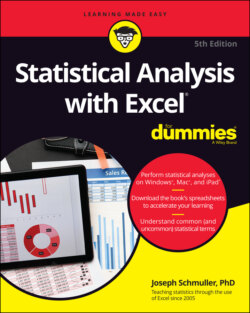Читать книгу Statistical Analysis with Excel For Dummies - Joseph Schmuller - Страница 16
A little probability
ОглавлениеWhen statisticians make decisions, they express their confidence about those decisions in terms of probability. They can never be certain about what they decide. They can only tell you how probable their conclusions are.
So, what is probability? The best way to attack this is with a few examples. If you toss a coin, what's the probability that it comes up heads? Intuitively, you know that if the coin is fair, you have a 50-50 chance of heads and a 50-50 chance of tails. In terms of the kinds of numbers associated with probability, that’s ½.
How about rolling a die? (That’s one member of a pair of dice.) What’s the probability that you roll a 3? Hmm… . A die has six faces and one of them is 3, so that ought to be 1⁄6, right? Right.
Here’s one more. You have a standard deck of playing cards. You select one card at random. What’s the probability that it’s a club? Well, a deck of cards has four suits, so that answer is ¼.
I think you’re getting the picture. If you want to know the probability that an event occurs, figure out how many ways that event can happen and divide by the total number of events that can happen. In each of the three examples, the event we’re interested in (heads, 3, or club) happens only one way.
Things can get a bit more complicated. When you toss a die, what’s the probability you roll a 3 or a 4? Now you're talking about two ways the event you're interested in can occur, so that's . What about the probability of rolling an even number? That has to be 2, 4, or 6, and the probability is .
On to another kind of probability question. Suppose you roll a die and toss a coin at the same time. What's the probability you roll a 3 and the coin comes up heads? Consider all the possible events that can occur when you roll a die and toss a coin at the same time. The outcome can be a head and 1-6 or a tail and 1-6. That's a total of 12 possibilities. The head-and-3 combination can happen only one way, so the answer is .
In general, the formula for the probability that a particular event occurs is
I begin this section by saying that statisticians express their confidence about their decisions in terms of probability, which is really why I brought up this topic in the first place. This line of thinking leads me to conditional probability — the probability that an event occurs given that some other event occurs. For example, suppose I roll a die, take a look at it (so that you can't see it), and tell you I’ve rolled an even number. What’s the probability that I've rolled a 2? Ordinarily, the probability of a 2 is 1⁄6, but I’ve narrowed the field. I’ve eliminated the three odd numbers (1, 3, and 5) as possibilities. In this case, only the three even numbers (2, 4, and 6) are possible, so now the probability of rolling a 2 is 1⁄3.
Exactly how does conditional probability play into statistical analysis? Read on.
